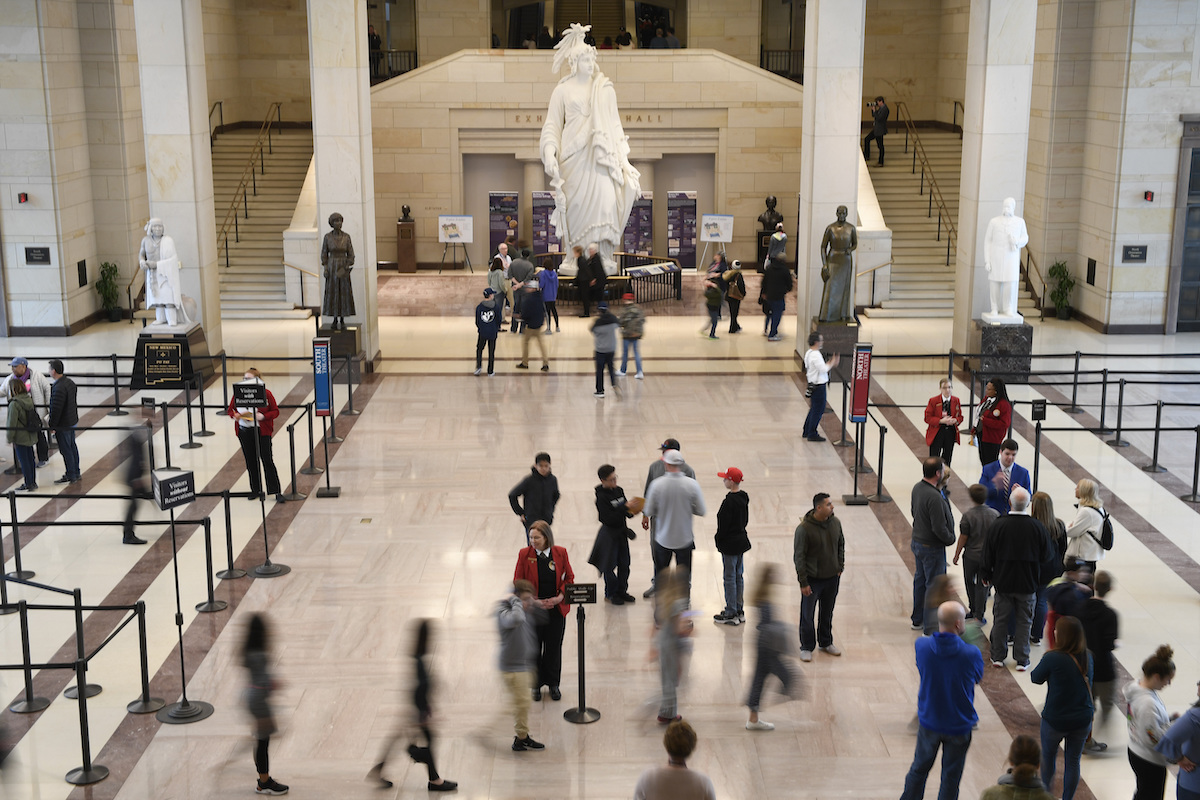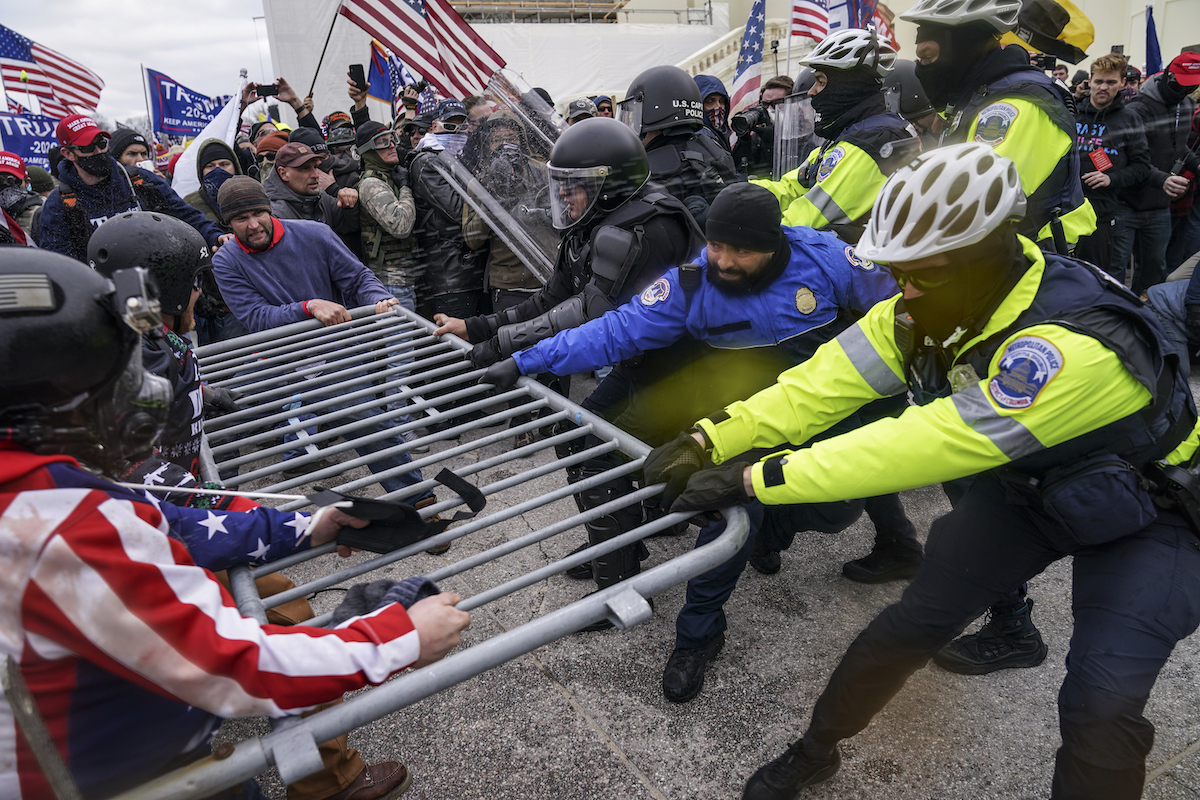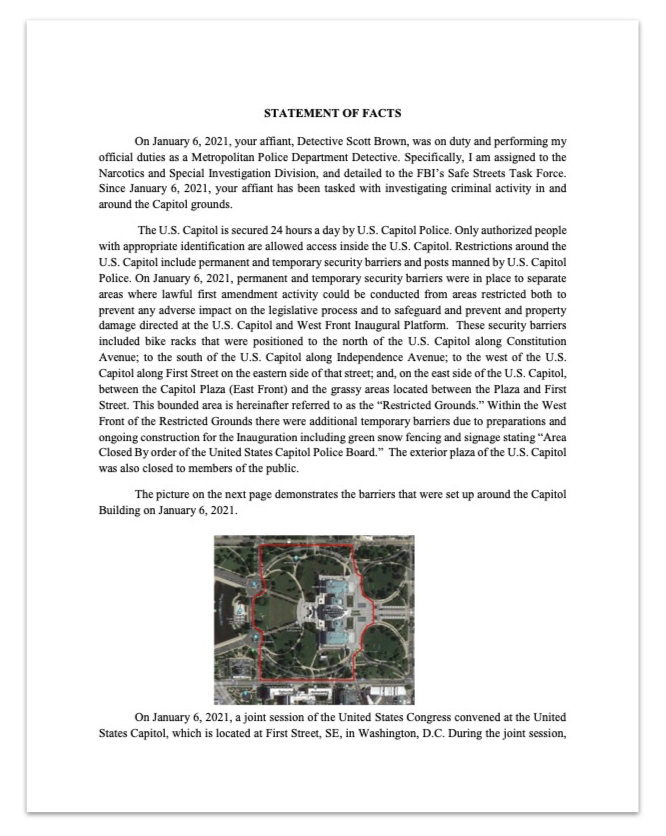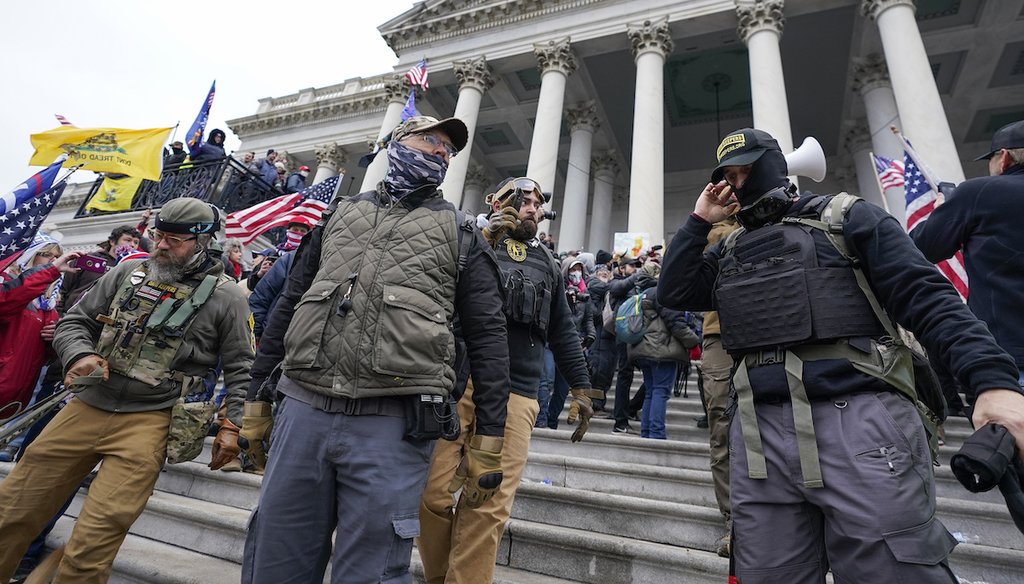



Members of the Oath Keepers on the East Front of the U.S. Capitol on Jan. 6, 2021, in Washington. (AP)
After CNN host Brianna Keilar said that the Oath Keepers’ entry into the U.S. Capitol on Jan. 6, 2021, was "clearly illegal," attorney Jonathon Moseley claimed in response: "I've had lunch in the Capitol for no reason. It’s not illegal to go inside the Capitol."
In normal times, members of the public can enter the Capitol for tours or to watch Congress in action. But their access is limited, as they have to enter into the building through security checkpoints, obtain the proper passes, stay out of restricted areas and follow other rules and procedures.
The Jan. 6 rioters who violently pushed past barricades, fought police and broke into the Capitol did not follow these rules and procedures — and they stormed the building on a day when it was closed to the public due to the COVID-19 pandemic.
In a verbal sparring match with CNN anchor Brianna Keilar, a lawyer representing Oath Keepers militia leaders charged with some of the most serious crimes involving the Jan. 6, 2021, attack on the U.S. Capitol offered up a new line of defense for his clients.
"I've had lunch in the Capitol for no reason," attorney Jonathon Moseley said during the Feb. 1 interview. "It's not illegal to go inside the Capitol."
"Did you break through the window to get into lunch?" Keilar interjected, as the network aired footage of the rioters forcing their way through Capitol doors.
"Hundreds of people do it everyday," Moseley said in response. "We’re getting into a lot of the weeds in terms of whether the signs making an exception that day were visible or not."
Moseley, an attorney and self-described activist, is representing several Jan. 6 defendants. Keilar introduced him as counsel for Stewart Rhodes, the leader of the far-right Oath Keepers militia, and Kelly Meggs, head of the group’s Florida chapter. Rhodes and Meggs were two of the 11 Oath Keepers indicted on charges of seditious conspiracy for their pre-planning and coordination on Jan. 6, which involved stationing weapons across the Potomac River in Virginia.
In an email to PolitiFact, Moseley said his on-air comment was being misinterpreted, and that he was talking on CNN about what’s "normally" allowed at the Capitol.
"You do not need a reason to enter the U.S. Capitol," Moseley said. "You can enter any time you want during business hours just because you feel like."
But the attorney’s comments on CNN came during a back-and-forth about Jan. 6, in response to Keilar’s claim that the way the Oath Keepers and other rioters entered the Capitol was "clearly illegal." The implication — and the impression viewers could have come away with — was that it is "not illegal" to enter the Capitol as the Oath Keepers and other Jan. 6 rioters did.
That’s wrong. The rioters pushed past barricades, scaled walls, fought with police, and broke through windows, storming into the building on a day when it was closed to the general public.
That’s why the Justice Department charged approximately 640 of the first 725 people arrested for the attack with entering or remaining in a restricted federal building or grounds.
"When it comes to the violations on Jan. 6, it is not relevant whether or not the U.S. Capitol is a public building," the Capitol Police said in a statement to PolitiFact. "It was not open to the general public that day. First, because of the COVID-19 pandemic. Second, because of the Joint Session of Congress. The rioters violated the law the moment they crossed the police line."
There was once a time when the general public could stroll into the Capitol building with no limits, but those days are decades in the past, according to a report from the United States Capitol Historical Society. Security measures ramped up over time, first after bombings in 1974 and 1983, and then with the installation of the $600 million Capitol Visitor Center, which opened in 2008 and followed the fatal shooting in 1998 of two Capitol Police officers.
Nowadays, the public’s access to the Capitol is much more restricted, and even that access has halted as the building closed to the public during the COVID-19 pandemic.

Tourists visit the Capitol Visitors Center on Capitol Hill in Washington on March 12, 2020. (AP)
"It's only legal to go into the Capitol buildings when and to the extent that they are open to the public," said David Alan Sklansky, a professor of law at Stanford Law School.
Even if the Capitol had been open on Jan. 6, Sklansky said, it would have still been illegal for the rioters to wander as they did into areas off-limits to the public — such as the floor of the Senate Chamber.
Before the pandemic, and only during business hours, the public could enter through the Capitol Visitor Center and its associated security checkpoints for guide-led tours requiring a pass, said Jane L. Campbell, president and CEO of the United States Capitol Historical Society.
They could observe House or Senate proceedings from the upper-level galleries that surround the chambers if they got passes by contacting or visiting the offices of their representatives or senators. They could also visit other areas by appointment.
Those who stormed the Capitol didn’t enter through the Capitol Visitor Center; they didn’t go through security screenings; they didn’t reserve tour slots, stick to designated tourist zones, and stay with tour guides; and they didn’t get passes to enter the Senate or House galleries.
PolitiFact rated the claim that the attack was a "normal tourist visit" Pants on Fire.

Rioters try to break through a police barrier at the Capitol in Washington on Jan. 6, 2021. (AP)
In his email to PolitiFact, Moseley argued that there were "no warning signs" indicating that the Capitol was closed due to COVID-19. "Legally, the most public government building in the world is not closed due to COVID-19 unless the public is given notice," Moseley wrote.
But in the same response, Moseley also acknowledged that the police barricades surrounding the building had signs indicating that the area was closed.
The Justice Department has described in charging documents the permanent and temporary barriers, including bike racks and fencing around the Capitol, that separated the "restricted grounds" on Jan. 6 from the areas where the permitted rallies that day were to take place.

A screenshot from Justice Department charging documents in a case related to the Capitol attack shows a description and map of the barriers in place on Jan. 6, 2021.
"Due to the ongoing COVID-19 pandemic, the U.S. Capitol Building and Congressional Office Buildings remain closed to the public," the U.S. Capitol Police’s website said on Jan. 6, 2021.
Charging documents alleged that the Oath Keepers brought "paramilitary gear, weapons, and supplies-including knives, batons, camouflaged combat uniforms, tactical vests with plates, helmets, eye protection, and radio equipment to the Capitol grounds." Weapons are on the list of items "strictly prohibited" inside the Capitol.
While Rhodes did not enter the Capitol himself, prosecutors said he orchestrated the Oath Keepers’ attack and "oversaw two military-style stacks of co-conspirators who, along with other rioters, forcibly breached the Capitol while armed QRF teams stood by, awaiting deployment."
Meggs was a part of one such stack that prosecutors said joined the rioters as they clashed with police and breached the Capitol doors. The stack "stormed into the Capitol alongside the mob."
Moseley said that "it’s not illegal to go inside the Capitol" as the Oath Keepers and other Jan. 6 rioters did.
The public can enter the Capitol when the building is open, assuming they abide by certain procedures and rules governing what’s allowed inside.
But the Jan. 6 rioters violently stormed the building on a day when it was closed to the public. They fought off police and knocked over the barriers that secured the outside before breaking in and entering restricted areas. Many carried weapons not allowed on Capitol grounds.
We rate this claim False.
CNN, "New Day with John Berman and Brianna Keilar," Feb. 1, 2022
U.S. Capitol Police, "Building Access & Hours," accessed Feb. 2, 2022
U.S. Capitol Visitor Center, "Plan A Visit," accessed Feb. 2, 2022
U.S. Capitol Visitor Center, "Prohibited Items," accessed Feb. 2, 2022
Architect of the Capitol, "Capitol Visitor Center," accessed Feb. 2, 2022
U.S. Justice Department, "Capitol Breach Cases," accessed Feb. 2, 2022
Mediaite, "Oath Keepers Lawyer Defends Clients in Heated Clash With CNN’s Brianna Keilar: ‘It’s Not Illegal to Go Inside the Capitol,'" Feb. 1, 2022
The Washington Post, "When will the people’s House be returned to the people? Not even Capitol officials know," Dec. 4, 2021
WUSA9, "VERIFY: No, the public does not have the right to be in the Capitol or on public property whenever they want," Sept. 16, 2021
The New York Times, "By the People, for the People, but Not Necessarily Open to the People," Jan. 12, 2021
Emailed statement from the U.S. Capitol Police, Feb. 2, 2022
Email correspondence with Tom Casey, director of marketing and communications at the U.S. Capitol Visitor Center, Feb. 2, 2022
Email interview with David Alan Sklansky, professor of law and faculty co-director of the Criminal Justice Center at Stanford Law School, Feb. 2, 2022
Email interview with Jane L. Campbell, president and CEO of the United States Capitol Historical Society, Feb. 3, 2022
In a world of wild talk and fake news, help us stand up for the facts.
